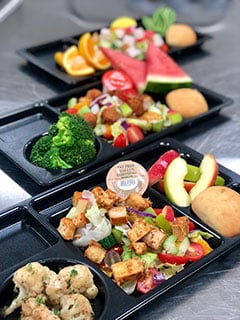
That first lunch consisted of a one-option menu — “Chicken and Dressing and Lima Beans.” The chicken had been donated by a staff member and was prepared by a “Mrs. Peevy” who managed the program and prepared daily lunches with the help of three other “neighborhood ladies.” Records show 34 students were fed that day in what was the genesis of the school lunch program.
In its infancy, the program was a true community effort. Almost all items were donated, either by the kitchen staff or by local farmers who typically brought items like cornmeal, eggs, potatoes and milk.

With such unwavering support and dedicated staff, the school nutrition program blossomed. Today, more than 180,000 students are enrolled in Gwinnett County Public Schools, and about 70 percent of that population eats lunches served in the school cafeterias.
According to Karen Hallford, Director of GCPS Nutrition Program, the cafeteria operates at a high level of professionalism and caters to its customer base, much like “A restaurant in a school.” Café Gwinnett, as the nutrition program has been coined in recent years, does, of course, follow federal nutritional standards and adheres to those regulations to serve fresh, healthy meals.
But program coordinators aim to give students as much choice as possible.
“We try to find a balance between serving compliant meals and serving kids what they are wanting. So, we hold focus groups with 8 to 10 students asking questions to find what they love and what they don’t,” Hallford said. From there, the coordinators work to find more nutritious alternatives to what the students requested.
“Menus today are very different than when they started. There are 180,000 students in the system, and while not all students eat lunch with us each day, we strive to provide options that will appeal to them and bring more customers in,” Hallford said.
The current nutrition model incorporates a farm-to-school process where school cafeterias purchase fresh produce one to two times each week.

GCPS serves an average of 120,000 lunches daily, and their lunch staff is the largest it’s ever been with 1,500 employees who ensure students have hot meals and fresh options every day throughout the school year.
A far cry from the days of water-rationing, the school cafeterias also serve breakfasts where students have an array of beverage choices.
To Hallford, the best part about the program’s expansion is that schools are helping students with healthy diets so they can do their best in class and in their extracurriculars. “School lunch is truly healthier than ever before,” she said.
More information about Café Gwinnett can be found through the School Nutrition page. Visit online at www.gwinnett.k12.ga.us. 

